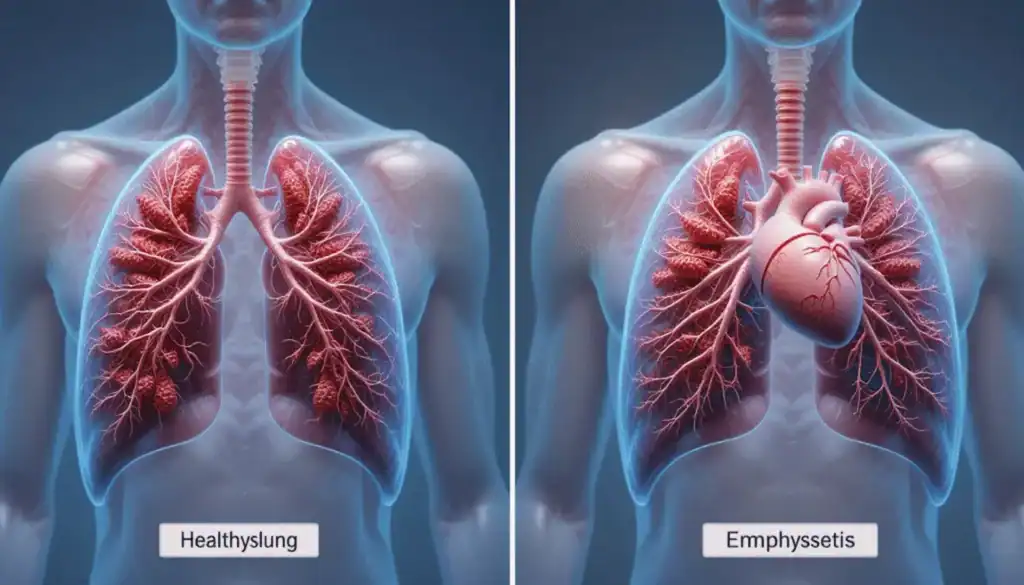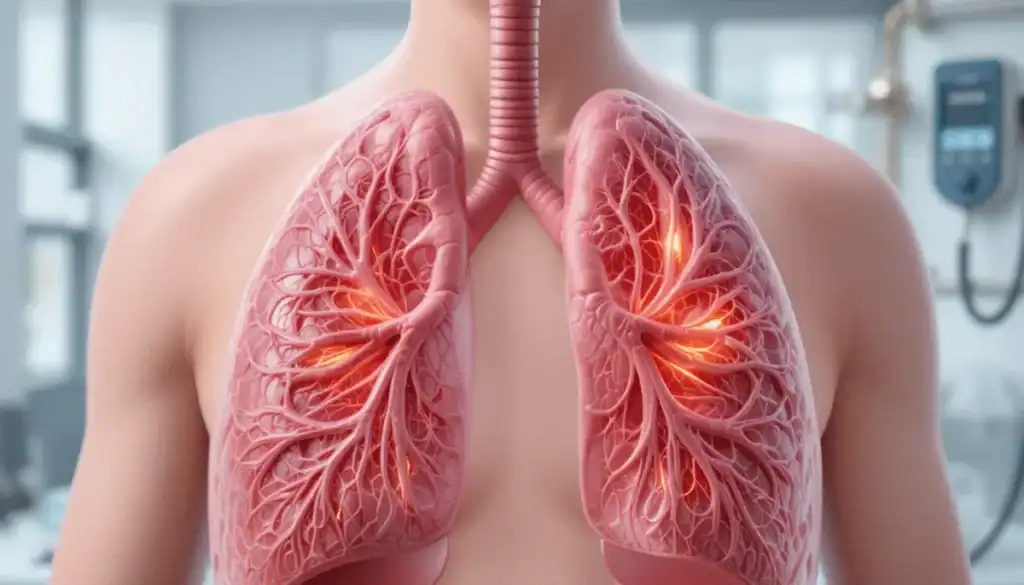Chronic Obstructive Pulmonary Disease, or COPD, is a progressive respiratory condition that results in airflow obstruction due to damage and inflammation in the lungs. This post explores the causes, clinical features, diagnostic strategies, and up-to-date management of COPD based on the latest GOLD (Global Initiative for Chronic Obstructive Lung Disease) guidelines.
🔍 What Is COPD?
COPD is a chronic obstructive pulmonary disease marked by irreversible airflow obstruction. It occurs due to a combination of:
- Small airway obstruction
- Parenchymal (alveolar) destruction
This obstructive pattern leads to difficulty in exhaling air out of the lungs.
COPD vs Asthma
- Asthma = Reversible airflow obstruction
- COPD = Irreversible airflow obstruction
🔬 Types of COPD
COPD comprises two overlapping conditions:
1. Chronic Bronchitis
Defined as a productive cough lasting for at least 3 months per year for 2 consecutive years. Caused mainly by:
- Smoking-induced damage
- Mucus hypersecretion
- Bronchial obstruction
2. Emphysema
Characterized by destruction of alveoli and enlargement of airspaces distal to terminal bronchioles. This leads to poor gas exchange and breathlessness.
🔸 In practice, most COPD patients have features of both conditions.
⚠️ Causes of COPD
Exogenous Causes
- Smoking (90% of cases)
- Air pollution
- Occupational exposure (coal, silica, fumes)
- Indoor biomass fuel (wood, animal dung)
Endogenous Causes
- Alpha-1 Antitrypsin Deficiency (in young non-smokers)
- IgA deficiency
- Kartagener syndrome
📊 GOLD Classification of COPD
COPD severity is classified using:
- Spirometry: Measures FEV₁ (Forced Expiratory Volume in 1 second)
- CAT Score: COPD Assessment Test (symptom-based)
- mMRC Dyspnea Scale: Based on breathlessness during activities
- Exacerbation Frequency: Number of flare-ups per year
Spirometry-Based GOLD Grades
| GOLD Grade | Severity | FEV₁ % Predicted |
|---|---|---|
| GOLD 1 | Mild | ≥ 80% |
| GOLD 2 | Moderate | 50–79% |
| GOLD 3 | Severe | 30–49% |
| GOLD 4 | Very Severe | < 30% |
🧪 Clinical Features of COPD
- Chronic productive cough (especially in chronic bronchitis)
- Dyspnea (initially exertional, then at rest)
- Pursed-lip breathing
- Tripod position (leaning forward with hands on knees)
- Prolonged expiration
- Barrel-shaped chest
- Wheezing and decreased breath sounds
🔎 Diagnostic Workup
1. Spirometry
- Diagnostic gold standard
- FEV₁/FVC ratio < 70%
- FEV₁ predicts severity
2. DLCO (Diffusion Test)
- Normal in chronic bronchitis
- ↓ in emphysema due to alveolar destruction
3. Chest X-ray
- Hyperinflated lungs
- Flattened diaphragm
- Tubular heart
- Increased AP diameter (barrel chest)
4. ABGs (Arterial Blood Gases)
- Indicated in severe cases or exacerbations
- Reveals hypoxia and/or hypercapnia
5. Alpha-1 Antitrypsin Testing
- Especially in young, non-smoker patients
6. CBC
- Elevated hematocrit due to chronic hypoxia
💊 Treatment of Stable COPD
🔸 Short-Acting Bronchodilators (SABAs)
- Albuterol (90 mcg per puff): Used 4–6 hourly PRN
🔸 Long-Acting Bronchodilators (LABAs)
- Salmeterol (50 mcg BID)
- Preferred in moderate to severe COPD
🔸 Long-Acting Muscarinic Antagonists (LAMAs)
- Tiotropium (18 mcg OD)
- Improve symptoms and reduce exacerbations
🔸 Inhaled Corticosteroids (ICS)
- Used in combination with LABA or LAMA for frequent exacerbators (Group C or D)
🔸 Antibiotic Prophylaxis
- Azithromycin may reduce exacerbation risk
🌬️ Long-Term Oxygen Therapy (LTOT)
- Indicated when O₂ saturation ≤ 88%
- Target O₂ saturation: 90–93%
- Improves survival in hypoxemic patients
⚠️ Never give 100% oxygen — risk of respiratory depression due to CO₂ retention.
🧪 Additional Therapies
- Mucolytics: N-acetylcysteine to loosen mucus
- Theophylline: Reserved for refractory cases
- Surgery: Lung volume reduction, bullectomy, or lung transplant in advanced disease
💡 Preventive Measures
- Smoking cessation: Most effective intervention to slow progression
- Vaccinations:
- Annual influenza vaccine
- Pneumococcal vaccine (for all COPD patients, especially age >65)
- Chest physiotherapy: Postural drainage for mucus clearance
- Pulmonary rehab: Exercise training, education, nutritional advice
⚠️ Complications of COPD
- Chronic respiratory failure
- Cor pulmonale (right heart failure)
- Recurrent infections
- Spontaneous pneumothorax
- Polycythemia due to chronic hypoxia
🧾 Summary
- COPD is an irreversible obstructive airway disease caused by chronic exposure to toxins (mainly smoking).
- Diagnosis is confirmed with spirometry (FEV₁/FVC < 70%).
- GOLD classification helps guide treatment based on spirometry, symptoms, and exacerbation history.
- Management includes bronchodilators, ICS, LTOT, smoking cessation, vaccinations, and rehab.
- Only smoking cessation and long-term oxygen therapy have shown to reduce mortality.



